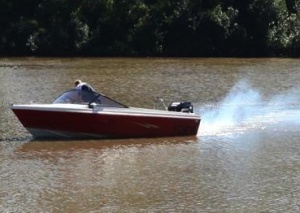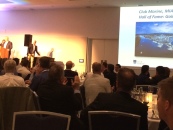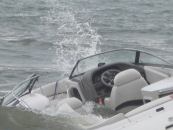In April 2014, the Commonwealth Environment Minister, the Hon Greg Hunt MP, secured the agreement of Australia’s Environment Ministers to work together to develop a National Clean Air Agreement by July 2016.
The proposed Agreement will focus on actions to reduce air pollution and improve air quality through cooperative action between industry and government. After engaging business, industry and community representatives on the development of the Agreement in the first half of this year, the government is now considering more than 300 submissions gathered. A Clean Air Champions Initiative was also set up to assist the government in educating the public and create awareness, and to support industry and community engagement on clean air activities.
One of the major proposed changes included in the Agreement is the phasing-out of the carburettor and EFI two-stroke engines.
Some significant changes for the outboard engines
Proponents of the changes say that the announcement should not come as a surprise. All of the outboard and marine industry leaders have been in discussions or government panels since 2006. Public consultation was held in 2010, when it was planned that standards could start in 2012.
Boat builders and Boat-Motor-Trailer (BMT) package retailers will have new responsibilities under the proposed laws. One of the US standards being matched includes an evaporative standard. Basically, the fuel system on every boat will need to be radically redesigned to dramatically reduce the pollution from fuel evaporation. In practice that means:
- Fuel tank expansion capacity (an overflow tank or ullage)
- Back flow limiting valves
- A carbon filter on the fuel breather line
- Low permeation fittings and fuel hoses.
Tote tanks (portable fuel tanks) will also have a new design and lower permeation. Any boat dealer who puts together BMT packages becomes a “manufacturer” under the proposed code.
Since taking office, the Hon Hunt has made it clear that Non Road Spark Ignition (petrol) engine emissions standards are back on the table. That includes outboards, inboards, stern drives PWC (Jet Ski) as well as lawn mowers, generators, brush cutters and chain saws. We will still see two-stroke handheld equipment like chainsaws, but only the high quality models will meet the softer standard necessary for handheld equipment.
According to the Gary Fooks, a technical analyst and chairman of Blue Sky Alliance, a group of manufacturers and distributors advocating for low-emission engines, the Australian standards will mirror those of the USA, which started regulating non-road engines seventeen years ago. It is the standard Europe is harmonising with. Carburettor two-strokes have been off the market in the USA, Canada and Japan for at least four years. He claims, “By the time Australia gets these standards, we will be five years behind China.”
Low emissions and clean air
The benefits of low-emission engines cannot be overemphasised. Nicholas Webb, director of Engine Products at Mercury Marine, states, “The benefit to users, by changing to new technology engines with low emissions, is improved fuel economy, quieter and smoother operation, and lower emission outputs.” The general agreed estimate of fuel saving from low-emission engines is 30%, but several manufacturers record much higher savings.
Will the benefits outweigh the costs? David Heyes of Bombardier Recreational Products (BRP) says, “The cost of a clean engine as part of a total BMT package does add some cost. However, customers who do their homework quickly realize that the small amount they pay extra for the new technology repays itself back over and over at the fuel pump and in reduced service cost.”
Even without these changes, there is a strong trend towards low emission technology with more than 50% of buyers already choosing engines that meet the world standards. Webb states, ”The low emissions trend is driven by new product development, particularly in four-stroke. For example, Mercury’s latest generation 115hp 2.1litre four-stroke model performs better, is more fuel efficient and is lower in weight, than Mercury’s previous 115 1.7L four-stroke model and the ever popular OptiMax Direct-Injection 115hp equivalent model.”
It is safe to say that direct-injection two-strokes, such as Evinrude E-TEC, and all the four-strokes currently on the market are here to stay. So, for around half the boating market, we will not notice any change.
Nothing owned now will be banned in any way, and spare parts for old two-strokes should be available for a few years yet. The regulations will only affect new imports after a certain date, which means that dealer stock and even stock at the importers’ warehouses will still be allowed to be sold.
Heyes states, “There should be no significant effect to outboard dealers who are now preparing boating packages with new technology engines, and the current compliant product offering provides consumers with a broad range to choose from. These changes will provide certainty in the market place and for owners of outboard engines, and will give confidence to customers about what to purchase and the benefits of those choices. To some degree, outboard dealers will reduce the level of stock offerings on the shop floor, in turn, reducing the cost of inventory finance.“
But when is “D” Day?
Minister Hunt announced that a working group, including industry representatives, has been formed, and is to report by the end of 2015 so he can deliver implementation in early 2016.
Industry insiders say that means the earliest possible date is 1 July 2016. But even if it starts that soon, there will be at least a phase-in period—how fast or slow will not be known for some months, with the industry representatives on the working group bound by the usual confidentiality rules.
Heyes declares, “BRP made the environmentally responsible decision to take carburettor and EFI two-strokes off the market some 10 years ago. I am predicting legislation is a difficult thing, but my personal guess is not before mid-2016, and it could drag on for a year or more, perhaps not across the range but in some limited categories. What the legislation will stop is USA and Japanese manufacturers dumping in Australia outboards that they are not allowed to sell in their own countries.”
Heyes continues, “This isn’t a dramatic change to hull design. Boat builders should all be ready by now. AS1799 Australian Boat Building Standard was updated for the emissions standard in 2009 so I would be concerned about a boat that is six years behind current standards.”
“This Evaporative standard will probably take a little longer to implement,” according to Fooks. “The best insider advice we could glean was that ‘Evap’ should be with the second and final part of the standards, probably 1 July 2017. We hear that the boating industry should be planning an education program. But in the meantime, USA web sites, like Perko, explain the new system very well.“
Fooks further states that any boat builder who has not made the necessary changes in seven years will not find much sympathy in Canberra. According to him, the best advice is to get any changes made now, and completed before 1 July 2016. “Boat builders should not waste any time getting ready, and will not be granted any extension of time. Authorities are very aware that the Australian Boat Building Standard (AS1799) was upgraded in 2009 to allow for heavier, low-emission four-strokes.”
As for the penalties involved for failure to comply with the new standards, Fooks warns, “Fit out a boat with low grade fuel line that does not meet the standard and be prepared to face hefty fines. If the USA is anything to go by, a $30,000 fine per boat is not out of the question.”
What engine distributors say
Engine distributors have their own statements on the proposed changes to the standards.
Heyes believes, “BRP are not worried about our own business or the industry to implement these changes. We all know that people fear change but similar regulations haven’t harmed the USA or Europe, not Japan or Canada. BRP are an innovative company that respects the environment and have won many awards for its technologies. We respect and support the Government’s efforts to bring emission regulations in line with international standards to our sector and welcome the positive approach our industry are taking on implementation.”
Webb suggests that any potential standards implemented should have plenty of runway for the marine industry and consumers to adapt. He says, “Consideration of special use categories need to be carefully considered in any potential standards. For example rescue use, where traditional two-strokes are still better suited to the specific critical needs of the operator. In recent years, large emissions reductions have already been achieved, well ahead of targets discussed by government, so the industry has been great by driving this change with its focus on new product development, and that will continue.” Further, Webb has commented that the US model is based on a range of different criteria, as well as Averaging, Banking and Trading which permit manufacturers to offset “dirty” two-stroke engines with cleaner technology.
Do you agree that two-stroke engines should be prohibited? Share us your thoughts by emailing editor@boatgoldcoast.com.au.
Interview with Gary Fooks of Blue Sky Alliance, David Heyes of Bombadier Recreational Products (BRP) and Nicholas Webb of Mercury Marine.
By Andy kancachian and Roselle Tenefrancia





























